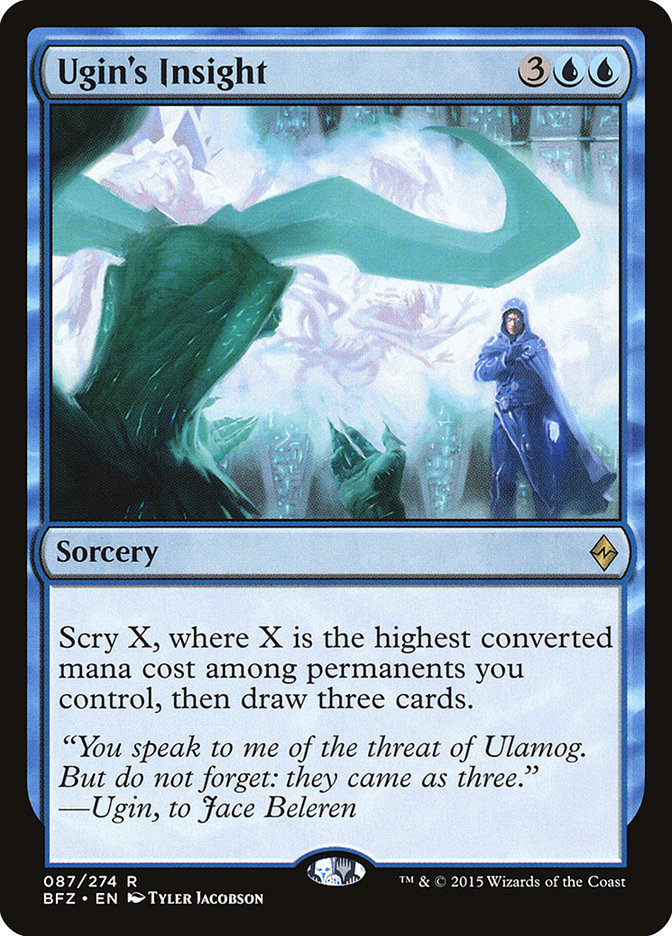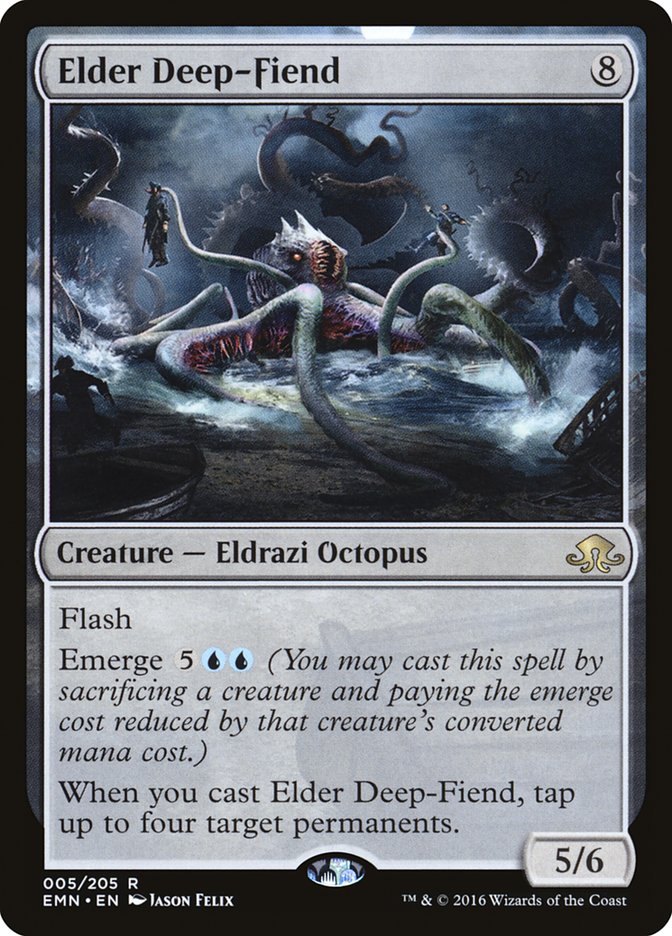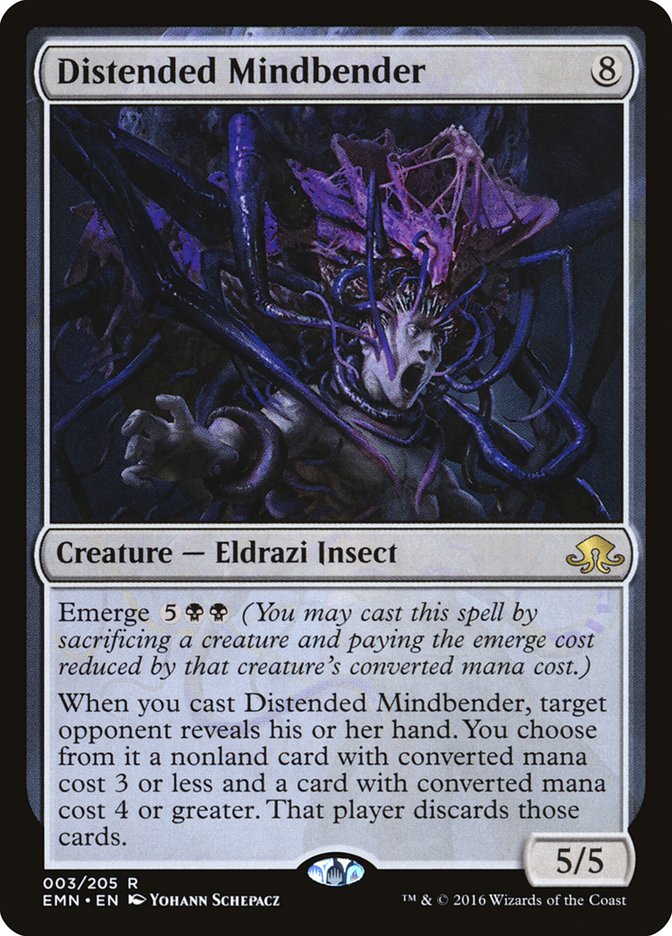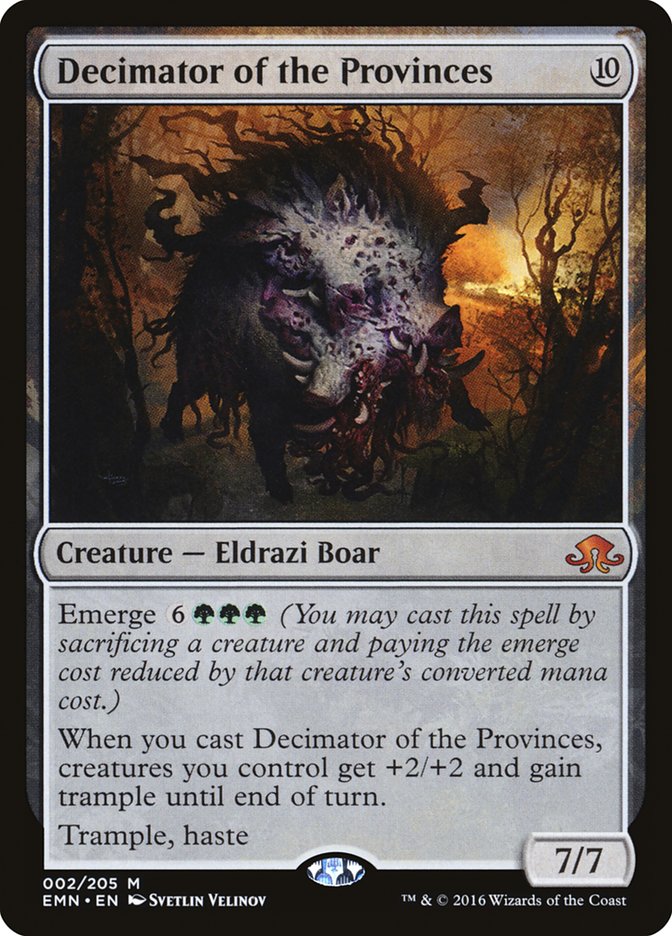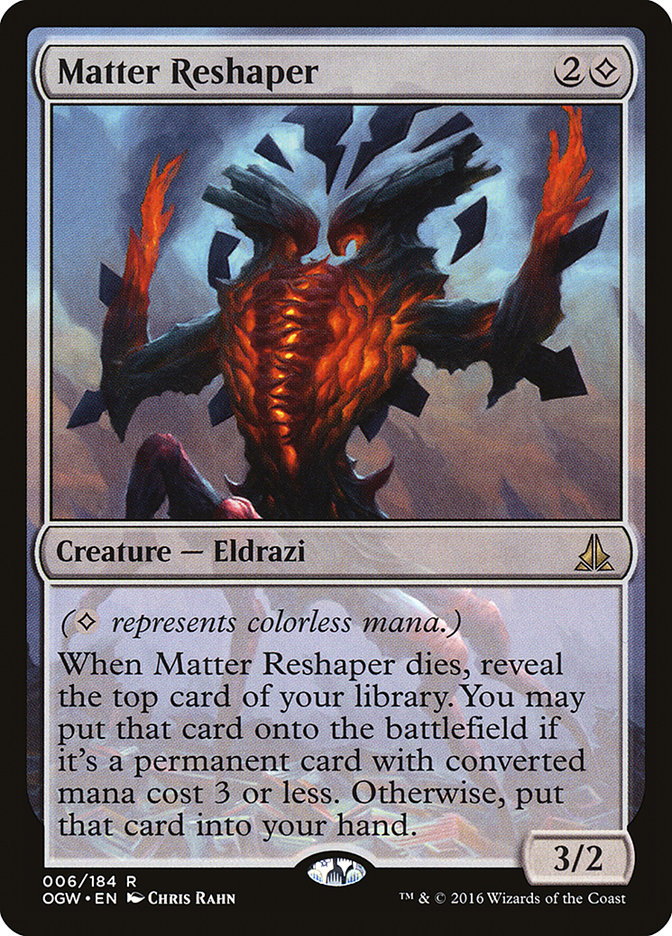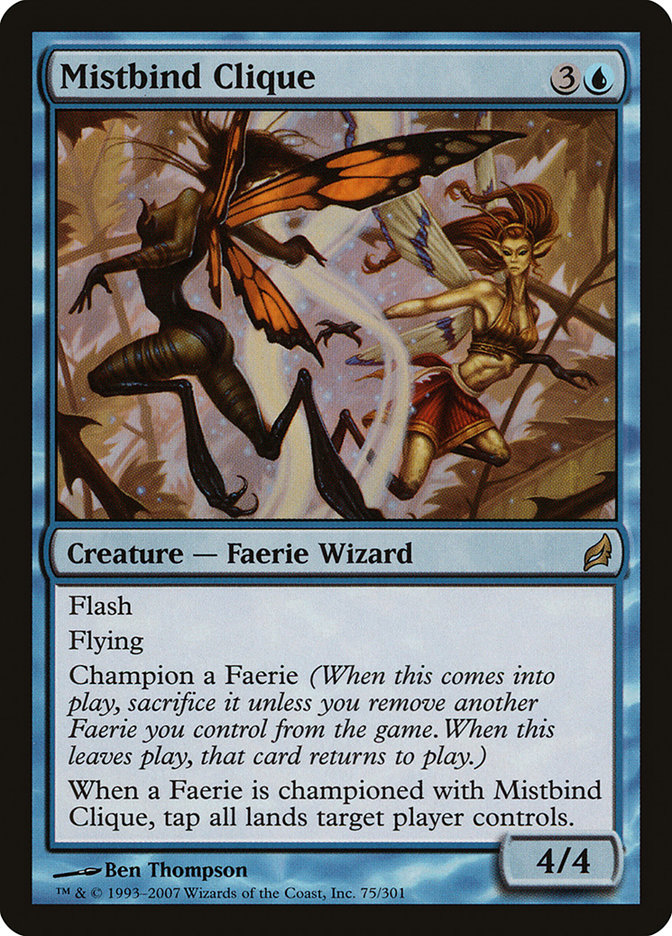“But do not forget: they came as three.”
Ugin may have predicted the threat of Emrakul, the Promised End, but there’s a different trio of Eldrazi that we should be deathly afraid of this coming Standard season:
If you’ve been looking at the spoilers, you know that Eldritch Moon is awesome. There are a ton of powerful cards and even the weird ones all seem to have a ton of potential as build-around-me cards. This set is brimming with interesting things to explore in addition to great flavor and design.
Last week, I lauded over Gisela, the Broken Blade and even more recently I may have declared her “the best card in the set as of this writing.” Well, it didn’t take me long to retract that statement.
Gisela is sick. Her stats are pushed and she has everything it takes to be a staple of the format, both straight up and when one is interested in building around her meld ability.
That being said, you know what you’re getting out of Gisela (at least as much as one can when dealing with a Horror that turns into an Eldrazi). She’s excellent, but still for the most part just a really powerful generic creature.
The Eldrazi with emerge, on the other hand, are scary.
It isn’t exactly clear what they are going to do in Eldritch Standard, but they will make their presence known. It won’t be just a single deck or archetype either. They all do different things while being independently immensely powerful and requiring very little initial investment.
So what am I making such a huge fuss about?
Cost reduction mechanics are inherently problematic. Being able to turn one resource into another seamlessly is a huge red flag. This has been a prevailing theme amongst many of Magic’s historically banned and broken elements over the years. It’s something that R&D has (for the most part) tried to avoid in the modern era of Magic.
Emerge is conceptually unfair.
Let’s take a look at this example of a card:
Majors’s Metaphor
3BB
As an additional cost to cast ~ sacrifice a nontoken creature.
When you cast ~, target opponent discards two cards.
5/5
This card is pretty good, right?
Well, Distended Mindbender is almost strictly (and yes, I’m aware of the nature of that word) better in every single way. It and all of its brethren’s abilities are viciously powerful and that’s completely ignoring the inherent strength of what these cards represent by simply existing as expensive Eldrazi creatures that one can “cheat” and cast.
Do you remember Modern decks (and there are still some now) that were built around trying to maximize low-cost World Breakers and Kozilek’s Return?
We now have multiple easy avenues to trigger Kozilek’s Return for functionally four and five mana.
We can now tutor for any colorless creature (including duplicate copies of these haymakers) on turn 4 with Sanctum of Ugin.
You can functionally Time Walk your opponent multiple turns in a row starting on the fourth turn.
Context is everything.
Getting on the battlefield is everything in Magic right now. Sacrificing creatures isn’t a real hindrance. If you have no traction, you probably aren’t winning anyway!
For that matter, there are a ton of powerful utility creatures that generate advantage when they enter the battlefield. Many of them cost three mana, which cleanly curve into two of these monstrosities.
Matter Reshaper is the clear stand out to me as the “obvious” one. It is an Eldrazi and we are already likely incentivized to be incorporating colorless mana into our deck. As a three-drop it cleanly curves into the Octopus or Insect, and it can generate significant value after being sacrificed. It will likely make up the core of many of these decks.
This is also probably as good a time as any to mention that it’s clear to me that Decimator of the Provinces is the weakest of the three, and it’s comparable to Craterhoof Behemoth!
Elder Deep-Fiend and Distended Mindbender both have immediate impacts on the battlefield without requiring additional resources once they’ve been cast. Not that a 7/7 with trample and haste is anything to sneeze at, but the Boar does cost significantly more. As I noted previously, Deep-Fiend can start functionally Time Walking an opponent as early as turn 4 and Distended Mindbender is functionally impossible to kill on the first turn as it strips your opponent of two of their best cards while on the stack and protected from removal.
While I’m talking in generalities, it may not exactly be intuitive that Emerge only reduces generic costs. In other words, sacrificing a creature costing BB will not reduce Distended Mindbender’s cost to 5 but rather 3BB.
So we need creatures and we are potentially incentivized to try to play a colorless land and a sweeper amongst three different colors? That almost sounds like too much ground to cover.
I suppose we’d best get started.
Here’s (I think) my best one:
Creatures (27)
- 4 Palace Familiar
- 1 Drowner of Hope
- 4 Eldrazi Skyspawner
- 3 Reality Smasher
- 4 Hedron Crawler
- 4 Matter Reshaper
- 3 Wretched Gryff
- 4 Elder Deep-Fiend
Lands (24)
Spells (9)

Check out this pretty average draw:
Turn 3: Eldrazi Skyspawner
Turn 4: Attack you, go. During your upkeep, sacrifice Eldrazi Skyspawner to emerge Eldrazi Deep-Fiend. Tap all of your lands, sacrifice Sanctum of Ugin to search for Reality Smasher.
Turn 5: Play fourth land, sacrifice Eldrazi Scion, cast Reality Smasher, attack for ten.
Your opponent is at seven to ten life and functionally didn’t have a third or fourth turn since their lands were tapped and they likely had no good attacks into your 5/6. If you were on the play, there is no single card that can catch them up, as you have two threats that are immune to Languish. Only Planar Outburst can feasibly do it all on its own from here.
This only requires two spells and a land!
A couple of things to note:
One is that this is the part of the article where I acknowledge Wretched Gryff’s existence. Sue me; I like the trio as a framing device. Gryff is yet another easy Kozilek’s Return enabler attached to a significant body that generates advantage. The fact that there are currently four emerge cards with rarities of C, R, R, M would also suggest that there are likely to be more on the way. This is either really exciting or terrifying, depending on your stance.
Second, Kozilek’s Return is actually fairly bad in this deck on the surface, but it’s so close to free! Not being able to naturally get it in the graveyard is a bit of an issue when we are interested in an aggressive curve and typically attacking our opponents, so Kozilek’s Return might actually be a trap. It could also just be an excellent sideboard choice against Company decks as a way to morph the deck into simply trying to go bigger and lean on a threat or two plus a huge trump catch-up spell. There are a ton of ways to construct this seemingly simple aggressive deck.
Finally, Elder Deep-Fiend is screwed up. This is a Mistbind Clique with absurd power creep. If you’ve never played against the Fae, it’s a nightmare that puts its opponents into devastating Catch-22s.
Oh you didn’t cast it during my upkeep? Well, if I attack, I might lose my best creature and get my lands tapped down, but if I just cast a spell and pass, I may lose the race. The more that the Deep-Fiend deck incorporates additional flash elements, the more this tension is pronounced.
Let’s take a look at that:
Creatures (30)
- 4 Knight of the White Orchid
- 4 Eldrazi Skyspawner
- 4 Reflector Mage
- 2 Bygone Bishop
- 2 Archangel Avacyn
- 4 Thraben Inspector
- 3 Rattlechains
- 4 Elder Deep-Fiend
- 3 Selfless Spirit
Lands (24)
Spells (6)

The issue with this color combination in general is that the mana is so problematic. It’s difficult to play on curve and cast your spells, especially when the majority of W/U’s early power is all in white. This coupled with the fact that we are interested in casting a UU spell on turn 4 means that there will inevitably be issues. It’s also basically impossible to incorporate the colorless package, which gives up some amount of power.
That all being said, there’s a lot to like here. Selfless Spirit is an awesome new addition that further powers up Rattlechains, and when one is representing any amount of Spirit shenanigans, Elder Deep-Fiend, Ojutai’s Command, or Archangel Avacyn, it’s basically impossible to play around getting blown out in some combination. Reflector Mage into Elder Deep-Fiend is also just a brutal curve.
I think there’s something here; this is just a fairly ugly representation of it.
Let’s get to work on that Insect:
Creatures (30)
- 4 Nantuko Husk
- 4 Elvish Visionary
- 4 Catacomb Sifter
- 2 Blisterpod
- 4 Zulaport Cutthroat
- 3 Duskwatch Recruiter
- 4 Loam Dryad
- 2 Emrakul's Evangel
- 3 Distended Mindbender
Lands (23)
Spells (6)

Between Emrakul’s Evangel and Distended Mindbender, G/B Aristocrats got a ton of upgrades in the raw power department. This is fortunate as it makes playing more low-power role players like Blisterpod and Loam Dryad a lot easier to stomach.
Your first reaction might be, “Isn’t this the deck for Decimator of the Provinces?” I don’t think so; rather, I think Decimator belongs in “go bigger” decks. For that matter, I also think the Boar will likely prove to be the hardest of the trio to build around. We’ll get to that shortly.
In a Collected Company deck, I’m much more interested in the Insect, since the deck is already so invested in trying to fill up with a bunch of threes. Playing any of your three-drops into the Mindbender is a great substitute for (and perhaps better than) a Collected Company.
When Cryptolith Rite decks are able to assemble massive battlefield positions that would be pumped by the Boar, they’re already likely winning. Instead, I think being able to target specific cards that are relevant to beating their strategy while generating a huge threat is exactly up this deck’s alley.
The other new addition, Emrakul’s Evangel, is immensely powerful precisely when Aristocrats has generated a massive position. Evangel functionally acts as a proxy Zulaport Cutthroat should you ever have Nantuko Husk on the battlefield, allowing you to “double up” on drain triggers. Additionally, it also helps to fight through Kalitas to some small extent by turning your exiled creatures into drain-friendly tokens. This isn’t exactly the cleanest solution, but it will facilitate wins when your opponent is at a lower life total.
Of course, there’s also just the ability to turn your incidental bodies into threatening 3/2s.
Here’s a take on “updating” B/W Eldrazi:
Creatures (18)
- 1 Pilgrim's Eye
- 3 Wasteland Strangler
- 2 Ayli, Eternal Pilgrim
- 2 Bearer of Silence
- 2 Hedron Crawler
- 4 Matter Reshaper
- 1 Emrakul, the Promised End
- 3 Distended Mindbender
Planeswalkers (5)
Lands (26)
Spells (11)

Okay, so there’s a lot of weird stuff going on here. I think it might be best to take this decklist as an example of “Here’s some of the stuff you may not have thought about that you have access to.” The point is that, if you go digging, there are incidental ways to gain incremental advantages in every color. This deck focuses on efficient removal and cheap interaction with Wasteland Strangler and Bearer of Silence as means to get on the battlefield and pressure an opponent while also fueling Distended Mindbender. This deck as it is constructed has a ton of incidental card types, which makes me excited to try the Liliana, the Last Hope and Emrakul, the Promised End engine.
Either you naturally mill the Emrakul and pick her right back up, or Sanctum of Ugin can find her later when your graveyard is already stocked and ready to go. Liliana’s place as a three-mana planeswalker is also excellent with Matter Reshaper. For that matter, even a good chunk of our “spells” are actually permanents, which play great with the card.
I’ve put the Boar off long enough. Like I said, I think that this deck is actually interested in going bigger, so let’s take a crack at it.
Creatures (24)
- 2 Elvish Visionary
- 1 Nissa, Vastwood Seer
- 4 Hangarback Walker
- 1 Linvala, the Preserver
- 3 Eldrazi Displacer
- 4 Sylvan Advocate
- 4 Matter Reshaper
- 2 Decimator of the Provinces
- 3 Ishkanah, Grafwidow
Lands (25)
Spells (11)

While we may be topping out and going for the kill with Decimator of the Provinces, this is really more of an Ishkanah, Grafwidow deck. The new Spider lord is an excellent payoff for delirium and is capable of gumming up both the ground and the air nicely.
Basically, the game plan is to buy time, assemble delirium, either naturally cast or Evolution into Ishkanah, and either kill our opponent with the Boar or assemble Eldrazi Displacer and Ishkanah as a means to go over the top of our opponent before eventually going for lethal with the Boar. There are a ton of different ways to construct a deck like this, especially when delirium is a goal involved, but I think this is what Decimator of the Provinces needs to be successful. Rather than simply trying to brute-force “Craterhoof” an opponent, your deck has to be constructed with a plan revolving around it as a trump.
The Grafwidow appears to fit the bill, but we are just beginning to scratch upon the surface of what it is possible with the Decimator and all the other emerge creatures. These decks are not simple to build and there’s a vast amount of depth in each approach, but the power is visibly apparent.
I think it’s finally time to admit that the true Eldrazi invasion of Standard is here. Emerge is undoubtedly the real deal. For better or worse, you may soon look back fondly on just having to beat a Gideon, Ally of Zendikar on the fourth turn.


